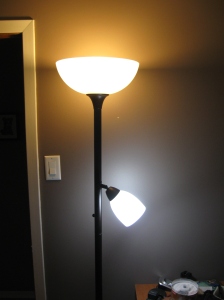I think by this point just about everyone knows that traditional incandescent lightbulbs are a very inefficient way to light your home. Most people I know have made some move toward replacing incandescent bulbs with compact fluourescent lights (CFLs). A CFL provides the same amount of light as an incandescent but uses only 1/4 of the electricity. While they are more expensive, the savings in electricity as well as their longer lifespan mean they are a mon ey saver as well.
ey saver as well.
CFLs have their limitations. Most CFL bulbs do not work with dimmer switches, cannot be used outside except in sealed fixtures, and give off a harsh blue light that is not nearly as pleasing as the soft yellow light produced by incandescents. Fortunately, progress is being made on these problems. CFLs that produce a pleasing yellow glow are now available. The difference is obvious in this picture. Unfortunately, I have not yet figured out how to tell the two types apart simply by looking at the package.
CFLs for use with dimmer switches are also becoming available. Unfortunately, they don’t seem to have all of the bugs ironed out just yet. We bought several last week for use in the basement (our house has lots of dimmers). Of six bulbs, one did not work, one continuously generates an annoying buzzing sound (even at full power) and the remainder do not produce nearly as much light as the incandescent bulbs they are designed to replace. I hope we will see some better products soon.
Even more energy efficient than CFLs are LEDs. For all intents and purposes, LEDs last forever (the fixture is likely to wear out before the bulb) and they use a tiny amount of electricity. We have a 1/4 watt LED nightlight that produces a lot more light than necessary (half that would be plenty). If the nightlight is on for 12 hours a day, it uses 1 kwh of electricity per year. That costs us less than 7 cents.
LEDs are becoming common in many applications. We have LED flashlights, I have an LED headlamp, newer city buses have LED turn signals and LED traffic lights are becoming increasingly common, but there are very few LED lights commonly available for household use so far. We have a three fixture track light in our bathroom that is normally filled with 50 watt halogen bulbs. I found 1/2 watt LED bulbs that fit the fixture, and replaced two of the halogen bulbs, but I have not replaced the middle bulb because the LEDs, like early CFLs, provide a somewhat dimmer and more bluish illumination than the halogen bulbs. In spite of the cost of almost $50 for the two LEDs, they are still a money saver, as they save us about $4 in electricity per year, and will never need replacing.
Using more energy efficient lightbulbs is one of the easiest steps anyone can take to reduce their carbon footprint, and it can be a big money-saver as well.
